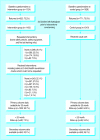Preventing injuries in children: cluster randomised controlled trial in primary care
- PMID: 10195971
- PMCID: PMC27827
- DOI: 10.1136/bmj.318.7189.980
Preventing injuries in children: cluster randomised controlled trial in primary care
Abstract
Objective: To assess the effectiveness of safety advice at child health surveillance consultations, provision of low cost safety equipment to families receiving means tested state benefits, home safety checks, and first aid training on frequency and severity of unintentional injuries in children at home.
Design: Cluster randomised controlled trial.
Setting: 36 general practices in Nottingham.
Subjects: All children aged 3-12 months registered with participating practices.
Interventions: A package of safety advice at child health surveillance consultations at 6-9, 12-15, and 18-24 months; provision of low cost safety equipment to families on means tested state benefits; and home safety checks and first aid training by health visitors.
Outcome measures: Primary outcomes measures were frequency and severity of medically attended injuries. Secondary outcome measures were self reported safety practices, possession and use of safety equipment, knowledge and confidence in dealing with first aid, and perceptions of risk of injury and risk of hazards assessed by postal questionnaire at baseline and follow up at 25 months.
Results: At baseline, both groups had similar risk factors for injury, sociodemographic characteristics, safety practices, possession and use of safety equipment, knowledge and confidence in dealing with first aid, and perceptions of risk. No significant difference was found in frequency of at least one medically attended injury (odds ratio 0.97, 95% confidence interval 0.72 to 1.30), at least one attendance at an accident and emergency department for injury (1.02, 0.76 to 1.37), at least one primary care attendance for injury (0.75, 0.48 to 1.17), or at least one hospital admission for injury (0.69, 0.42 to 1.12). No significant difference in the secondary outcome measures was found between the intervention and control groups.
Conclusions: The intervention package was not effective in reducing the frequency of minor unintentional injuries in children at home, and larger trials are required to assess the effect on more severe injuries.
Comment in
-
Preventing injuries in children. Elements of trial's design and analysis might have biased results.BMJ. 1999 Aug 28;319(7209):574-5. doi: 10.1136/bmj.319.7209.574a. BMJ. 1999. PMID: 10463909 Free PMC article. No abstract available.
References
-
- Child Accident Prevention Trust. The health visitor’s education and training resource. London: Child Accident Prevention Trust; 1991.
-
- Laidman P. Health visitors and preventing accidents to children. Research report 12. London: Health Education Authority; 1987.

